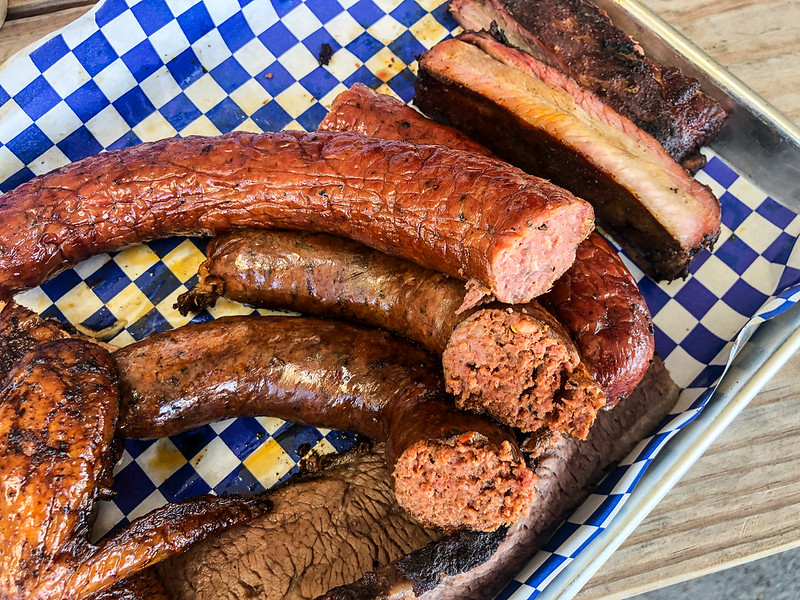A Guide To Sausage In Texas Barbecue

A selection of sausages from Lonestar Sausage & BBQ
The Texas trinity of brisket, ribs and sausage represents the diverse influences of smoked meats in the Lone Star State.
The story of how German butchers in Central Texas co-opted the cattle business of the area to create beef-centric meat markets, and later cooked meat, is well-known.
Pork ribs can be traced to Southern U.S. and African-American cooking traditions where whole hog cookery is still the primary focus of barbecue joints there.
And what about sausage? At most barbecue joints in Texas, ordering sausage is mostly an afterthought. If we are given any options, it might be between “regular” and “jalapeño.” Beyond that, we are at the mercy of the pitmaster as to the exact nature of those small discs of compressed meat that inhabit our tray next to the brisket and ribs.
Not surprisingly, the story of sausage in Texas barbecue is long and complex. But for the average diner, all we need to know is that the typical sausage served at our favorite barbecue joint originated from the area of Europe that is now Poland and the Czech Republic.
Although German immigrants to Texas get most of the credit for popularizing Central Texas-style barbecue, Polish and Czech immigrants also had a big influence, especially when it comes to sausage.
Indeed, the typical commercial sausage served at a barbecue joint is technically kielbasa (Polish) or klobasa (Czech). These are the same type of sausages we see at the local supermarket: thick, horseshoe-shaped loops of coarse-ground meat and spices that are also popular in backyard grilling. Typical brands include Chappell Hill, Burton and Prasek’s.
How did Polish and Czech sausages become the go-to choice for both professional and backyard pitmasters? It comes down to a combination of appealing flavors and textures as well as the ability to easily package and distribute them.
The flavor combines a mixture of pork and beef with a foundation of spices that include salt, pepper, garlic and paprika. The ingredients are coarsely ground and stuffed into a thin pork casing. The sausages are then partially cooked (usually smoked) and then set out in the meat case. Pitmasters can than finish cooking them on the grill or in the smoker.
Packaged sausages you find at the supermarket may also contain ingredients like sodium nitrite, which act as preservatives to lengthen shelf-life, though “uncured” sausage which substitutes natural preservatives like celery powder are also becoming more popular.
Regional sausage varieties also show up on barbecue joints in specific parts of the state. Though they are not on as many barbecue menus as there Polish/Czech variety, German-style, all-beef sausages known as “hot guts” are popular in Central Texas, specifically the city of Elgin. Southside Market and BBQ and Meyer’s Elgin Sausage are well-known purveyors.
The main difference between the two sausages is the German version is all beef and often adds cayenne pepper (no garlic), whereas the Polish/Czech version is pork-and-beef and always includes garlic. A version of German-style hot guts can be found in the small northeast Texas town of Pittsburg, where “Pittsburg Brand Hot Links” are a regional specialty.
In Houston, a New Orleans import called “chaurice” sausage has been one of the influential sausages of the city. This spicy Creole link was brought to Houston by Percy “King” Creuzot who founded the Frenchy’s Chicken brand here. East Texas-style joints like Burns Original BBQ became famous for selling it under the “homemade links” moniker.
With Burns leading the way, the chaurice sausage became a standard item on many barbecue menus starting in the 1970s and ’80s, bringing an unmistakable Creole flavor to Houston barbecue.
Another regional sausage specialty can be found in Beaumont, where the region’s Creole and Cajun influences have created a style of hot link affectionately known as “juicy links,” “homemade links,” “garlic bombs,” or “greaseballs.” Local joints like Patillo’s, Broussard’s and Gerard’s still hand-make these.
As the names suggest, these sausages — technically “links” based on how they are tied-off into smaller loops than their Central Texas counterparts — use a greater ratio of fat-to-meat and incorporate chunks of fresh garlic into a finer grind. There’s also plenty of spices and herbs thanks to the Cajun and Creole connection, including cumin, cayenne and paprika.
Though most Houston barbecue joints serve the Polish/Czech variety of sausage, it’s worth inquiring about hot guts in Central Texas and juicy links in Southeast Texas the next time you’re on the road.
How the HOUBBQ Guide helps: On the individual barbecue joint profile pages you can refer to the Known For section to determine if they have any specialty sausage offerings. In the Features Filter, you can filter for those barbecue joints that make their Sausage In-house.
